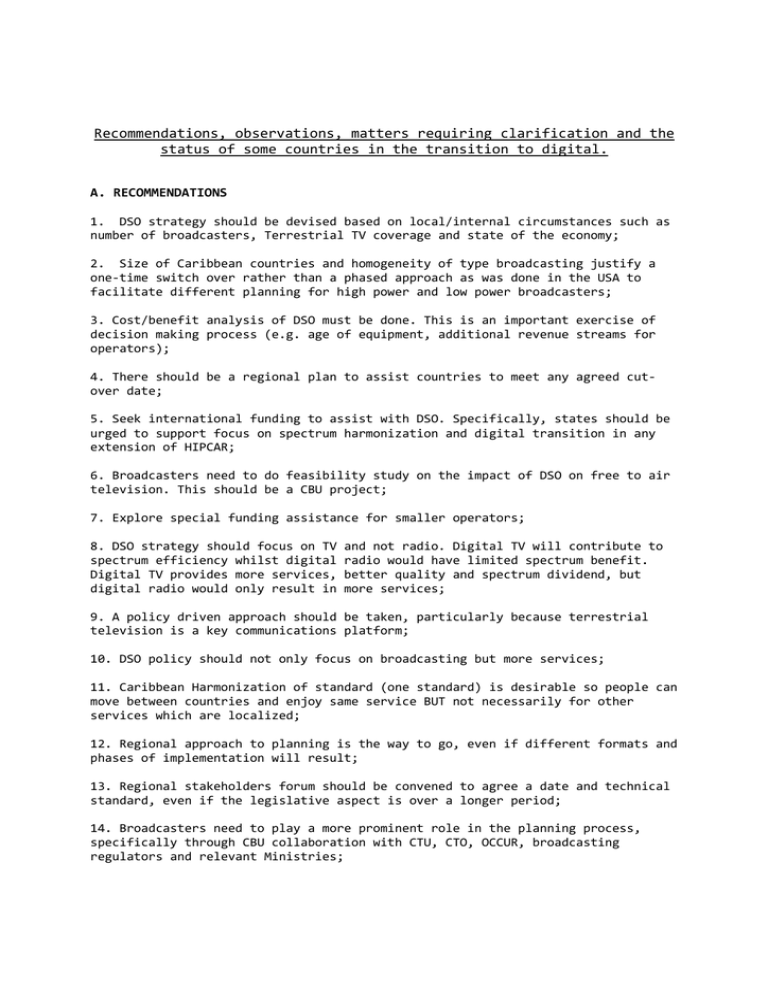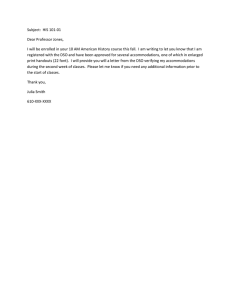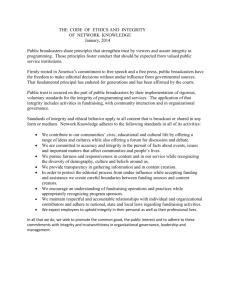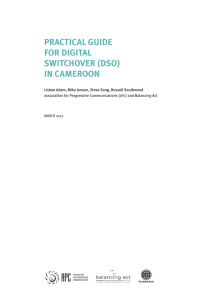Recommendations, observations, matters requiring clarification and the
advertisement

Recommendations, observations, matters requiring clarification and the status of some countries in the transition to digital. A. RECOMMENDATIONS 1. DSO strategy should be devised based on local/internal circumstances such as number of broadcasters, Terrestrial TV coverage and state of the economy; 2. Size of Caribbean countries and homogeneity of type broadcasting justify a one-time switch over rather than a phased approach as was done in the USA to facilitate different planning for high power and low power broadcasters; 3. Cost/benefit analysis of DSO must be done. This is an important exercise of decision making process (e.g. age of equipment, additional revenue streams for operators); 4. There should be a regional plan to assist countries to meet any agreed cutover date; 5. Seek international funding to assist with DSO. Specifically, states should be urged to support focus on spectrum harmonization and digital transition in any extension of HIPCAR; 6. Broadcasters need to do feasibility study on the impact of DSO on free to air television. This should be a CBU project; 7. Explore special funding assistance for smaller operators; 8. DSO strategy should focus on TV spectrum efficiency whilst digital Digital TV provides more services, digital radio would only result in and not radio. Digital TV will contribute to radio would have limited spectrum benefit. better quality and spectrum dividend, but more services; 9. A policy driven approach should be taken, particularly because terrestrial television is a key communications platform; 10. DSO policy should not only focus on broadcasting but more services; 11. Caribbean Harmonization of standard (one standard) is desirable so people can move between countries and enjoy same service BUT not necessarily for other services which are localized; 12. Regional approach to planning is the way to go, even if different formats and phases of implementation will result; 13. Regional stakeholders forum should be convened to agree a date and technical standard, even if the legislative aspect is over a longer period; 14. Broadcasters need to play a more prominent role in the planning process, specifically through CBU collaboration with CTU, CTO, OCCUR, broadcasting regulators and relevant Ministries; 15. Broadcasters to become partners in the process/ and to decide on standards. They should arrange with standard providers to carry out tests (requesting the provision of transmitters for that purpose and use by regional broadcasters); 16. Broadband should be developed in the same band across the region as it would make planning easier for regional operators; 17. Spectrum planning should be revisited and prioritized at the regional level e.g. CTU regional spectrum policy; 18. Environmental concerns should be prioritized to prevent dumping of television sets and improper disposal of harmful components e.g. those containing lead. 19. Both cable and public broadcaster have a role to play in public and communication; education 20. There should be a steering committee, preferably led by the relevant Minister but also a project management team. If left purely to broadcasters or regulators DSO could take too long and will not be done efficiently. An independent/higher level group is required; 21. National and regional road map teams should be established; and 22. Ministry of Culture must play a role in digital TV policy making. If we want to be present on screens we have to work with cultural sector. B. OBSERVATIONS 1. The system design is important. The choice of a Single frequency or multifrequency design will have implications for the standard to be adopted; 2. Single frequency network configuration is best for DVB whilst multi-network configuration is best suited for ATSC; 3. Not many countries in Region 2 (North America) are using DVB-T standard (European); 4. 6 MHz channel used by region 2 countries but DVB-T uses 8 channels. So, a lot of DVB-T boxes don't allow the option of 6 MHz; 5. Set top boxes are available for as low as $10 but these are the DVB standard and manufactured in limited numbers. 6. Technical implications (standard, deployment of digital transmitters and purchase of consumer equipment) are most important vis-a-vis political and legal issues; 7. A harmonized approach does not necessarily mean consistent dates but the manner/method by which Caribbean countries should go about DSO; 8. In a harmonized approach it is desirable that there be one standard as this would make it easier to purchase end user equipment; 9. If countries were to move in different directions this could cause interference problems. Countries would need to negotiate with neighbors to operate interference free if they have moved ahead of their neighbors; 10. Transition process/dates to be guided by availability of set-top boxes; procurement of equipment; capital expenditure; readiness of broadcaster; 2015 is do-able if there are one or two broadcasters to switch; 11. Government will fund stations they own (from taxes). Who will fund the commercial broadcasters?; 12. There needs to be a determination of the platform to be used for broadcasting e.g. use satellite or cable to distribute broadcasters and discontinue terrestrial broadcasting entirely. This turns on a decision about the importance of terrestrial broadcasting. 13. Provision of subsidy is not applicable to every country or to everyone should be properly researched; and 14. The analogue equipment is aging and nobody is manufacturing such equipment so a "cost/benefit analysis" might not be effective as there is no choice but to go digital. A 'least-cost' approach might be better. 15. Spectrum can be assigned either to each broadcaster or a multiplex. The latter approach would relieve broadcasters from paying hefty spectrum fees; 16. A signal distributor could help to expand the reach of broadcasters and remove existing burdens; 18. Cable network could deliver terrestrial stations in a partnership arrangement, to reduce distribution expenses/costs; 19. Young people are not watching terrestrial TV. Digital programming could attract youth to TV; 20. Since NTSC is being used in many region 2 countries, the should be a natural progression; ATSC standard 21. DVB has a more efficient capability to deliver data service and this could affect the business model for digital broadcasters (delivery of video and data services) 22. DSO can assist with broadband roll out and alleviate low internet penetration; 23. ITU has set no ASO date for America (Region 2). For Region 1 (Europe and Africa) a date was agreed by the administrations during the RRC-04 and 06 (see GE-06 Plan). In Africa for some countries in some bands it was extended until 2020. In North America, some countries (notably, USA) have planned transition dates which coincide with that of Region 2. Caribbean countries should decide what is important for the region and each country, bearing in mind trends in the North American region, global transition and other relevant factors such as culture, trade and economic realities. ITU is ready to continue its assistance in the organization of regional meetings with cooperation of CBU and CTU. C. ISSUE TO BE CLARIFIED What is the economic life of existing analogue broadcasting transmitters and systems (within countries and across the region)? D. COUNTRY STATUS 1. Suriname -Half million people; 100,000 households with TV; - Government TV is championing the move to digital switch-over and expected to be the multiplex operator; 2. Curacao -Transmitting in digital since 2009 -Selected DVB-T format because of the effect of the Netherlands; - No multiplexing; -3 FTA stations but only government station transmitting in digital; -Dual mode broadcasting being done (analogue and digital); -Set top boxes have to be purchased; no subsidies; -Cost of one box US$45 (very expensive); -Not many households have taken up digital offering, so it is difficult for a start up TV station; -Receives channels from Venezuela-but no problem now because they are transmitted by Venezuela in analogue; -Problem for local companies selling TV because they can't source from US 3. Barbados -Set top box subsidy does not seem plausible; -Speculation that ATSC standard will be favored; -Possible to switch by 2015 because only one TV station (govt. Owned); -No carriage of local TV on cable 4. Haiti -ATSC standard chosen -2 licenses for Digital TV issued; to come on stream 2012 -Telco through national ISP being allowed to provide TV services 5. Trinidad and Tobago -Framework document for DSO currently out for consultation; -Comments being solicited from stakeholders with a view to defining a Digital Terrestrial Working Group. 6. Jamaica -National Steering Committee established under chairmanship of Minister with responsibility for Information with three Co-chairs representing broadcasters, cable sector and regulator; -Digital Policy paper prepared; -ToR for DSO study completed and funding being sought 7. Europe - For members of EU Switch-over date is 2012 (but not all of them can manage it) - Some European countries won't be ready before 2015




